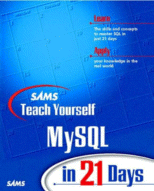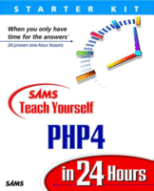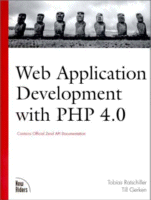Computer Book Reviews
Page Two of TwoSAMS Teach Yourself MySQL in 21 Days by Mark Maslakowski
Sams, June 2000.Trade Paperback, 532 pages.
ISBN: 0672319144
Ordering information:
Amazon.com.
 This guide helps introduce web developers
to MySQL, a powerful database tool that
many webmasters are using to add
online databases to their websites. This teach
yourself course and reference guides readers
through MySQL concepts and code over
a 21-day period. Each chapter in the book
is a new lesson to be completed and provides
instruction, example code, example
databases, definitions,
screenshots, tables, Q&A and exercises to
help readers grasp MySQL concepts.
Some of the concepts covered in the
reference include: installation, database
design, normalization, database creation,
tables and columns, data types, importing data,
SQL queries, locks, keys, database interfaces,
MyODBC, Perl DBI, PHP, Dates, Time,
security and administration.
The book also includes a handy reference
section containing SQL syntax and commands and
MySQL functions. The CD-Rom which comes
with book contains source code from the book
and third-party software.
This guide helps introduce web developers
to MySQL, a powerful database tool that
many webmasters are using to add
online databases to their websites. This teach
yourself course and reference guides readers
through MySQL concepts and code over
a 21-day period. Each chapter in the book
is a new lesson to be completed and provides
instruction, example code, example
databases, definitions,
screenshots, tables, Q&A and exercises to
help readers grasp MySQL concepts.
Some of the concepts covered in the
reference include: installation, database
design, normalization, database creation,
tables and columns, data types, importing data,
SQL queries, locks, keys, database interfaces,
MyODBC, Perl DBI, PHP, Dates, Time,
security and administration.
The book also includes a handy reference
section containing SQL syntax and commands and
MySQL functions. The CD-Rom which comes
with book contains source code from the book
and third-party software.
Website developers who are new to web databases will find valuable information in this book to help them develop and create an effective MySQL database, as well as instruction on how to connect the database to the website, using different programming tools such as Perl and PHP. Teach Yourself MySQL in 21 Days is a solid introductory reference guide for the beginner who is just starting to work with MySQL and web databases.
SAMS Teach Yourself PHP4 in 24 Hours by Matt Zandstra
SAMS, June 2000.Trade Paperback, 481 pages.
ISBN: 0672318040
Ordering information:
Amazon.com.
 Many webmasters have turned to PHP,
an open source Web scripting language, for its
quick and easy handling of web forms and for
dealing with MySQL databases and other
tasks where PHP can be used instead of
a complicated and time-consuming CGI program.
The book is divided into 24 chapters, each
of which is meant to be a one-hour lesson.
The lessons include question and answers,
summaries and short quizzes in addition
to the instruction and advice. PHP topics
covered in the book include:
PHP basics, functions, arrays, objects,
forms, files, DBM functions, database integration,
dynamic images, dates, data, strings, regular
expressions, cookies, query strings and debugging.
Many of the database examples in the book are
written to work with MySQL, which is
a good SQL database to work with because
PHP provides functions for working with
MySQL.
The book provides example code and sample
programs to help readers try out what they
are learning and follow along with the book.
Many webmasters have turned to PHP,
an open source Web scripting language, for its
quick and easy handling of web forms and for
dealing with MySQL databases and other
tasks where PHP can be used instead of
a complicated and time-consuming CGI program.
The book is divided into 24 chapters, each
of which is meant to be a one-hour lesson.
The lessons include question and answers,
summaries and short quizzes in addition
to the instruction and advice. PHP topics
covered in the book include:
PHP basics, functions, arrays, objects,
forms, files, DBM functions, database integration,
dynamic images, dates, data, strings, regular
expressions, cookies, query strings and debugging.
Many of the database examples in the book are
written to work with MySQL, which is
a good SQL database to work with because
PHP provides functions for working with
MySQL.
The book provides example code and sample
programs to help readers try out what they
are learning and follow along with the book.
Author Matt Zandstra runs a web design firm, Corrosive Web Design, and has taught courses on PHP. Zandstra's PHP coding examples and instruction are very clear and the lessons build gradually through the book, but a more experienced programmer could easily jump around the book to find specific information. This reference is targeted towards beginners, but a basic knowledge of HTML is recommended. PHP 4 is a great programming tool for online forms and database administration and this guide helps webmasters get going quickly on the basics.
Web Application Development with PHP 4.0 by Tobias Ratschiller and Till Gerken
New Riders, April 2000.Trade Paperback, 384 pages.
ISBN: 0735709971
Ordering information:
Amazon.com.
 This reference, which is aimed at more
advanced web programmers, shows how
PHP can be used to develop sophisticated
applications. PHP has grown in usage
because of its ease in handling forms and
MySQL database, and this reference also
touches on both of these uses. The first
section of the book covers advanced PHP
syntax, including object orientation, array
functions, linked lists, associative arrays
and self-modifying code. The second part of
the book covers developing web applications
including security issues, web application
strategies, CVS, databases, PHPLib, XML and
WDDX. Also provided are case studies about
companies successfully using PHP in
high-demand scenarios. A final section of
the book is the official documentation on
extending PHP 4.0 which shows you how to
write your own modules to extend PHP's
functionality.
This reference, which is aimed at more
advanced web programmers, shows how
PHP can be used to develop sophisticated
applications. PHP has grown in usage
because of its ease in handling forms and
MySQL database, and this reference also
touches on both of these uses. The first
section of the book covers advanced PHP
syntax, including object orientation, array
functions, linked lists, associative arrays
and self-modifying code. The second part of
the book covers developing web applications
including security issues, web application
strategies, CVS, databases, PHPLib, XML and
WDDX. Also provided are case studies about
companies successfully using PHP in
high-demand scenarios. A final section of
the book is the official documentation on
extending PHP 4.0 which shows you how to
write your own modules to extend PHP's
functionality.
The authors, Tobias Ratschiller, a new media consultant, and Till Gerken, a freelance Web developer, are very knowledgeable about PHP and all of the latest developments. They also manage a PHP website, phpWizard.net. This is a great reference that demonstrates real use of PHP to develop practical applications. The book assumes that the reader has at least some working knowledge of PHP and web programming. Novices to the language should try an introductory PHP reference first such as PHP Essentials or Teach Yourself PHP4 in 24 Hours.
Computer Reviews
Page One | Page Two
Return to the September 2000 issue of The IWJ.
More from Writers Write
